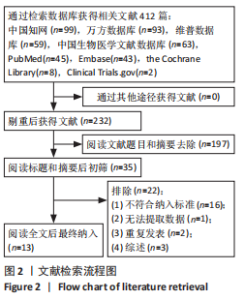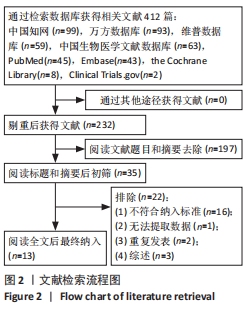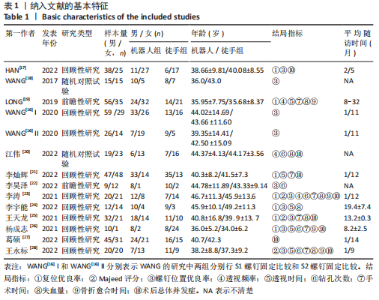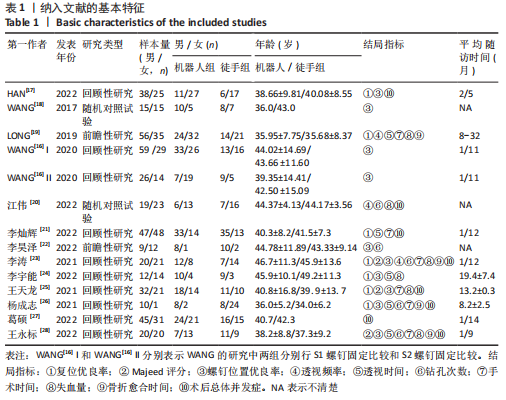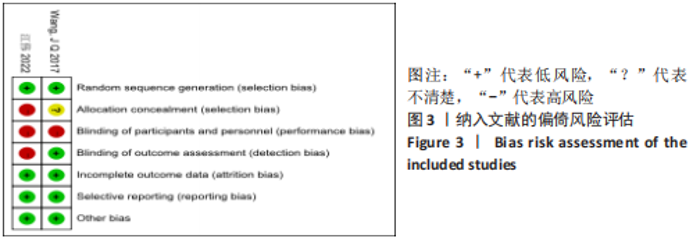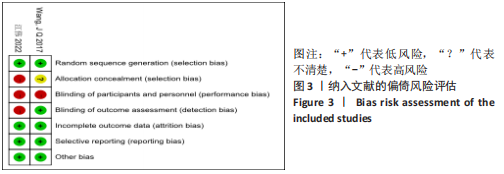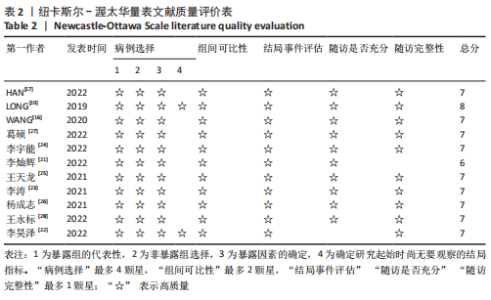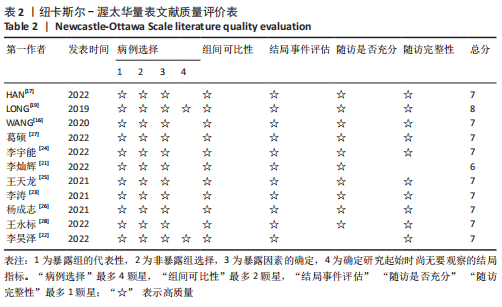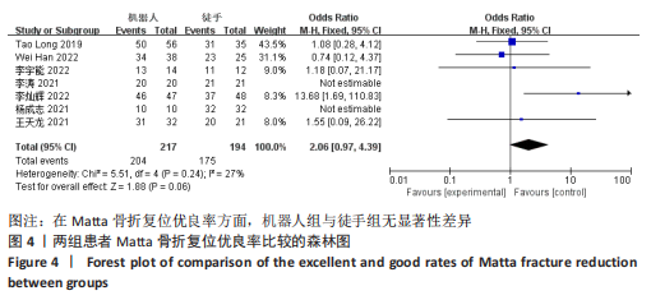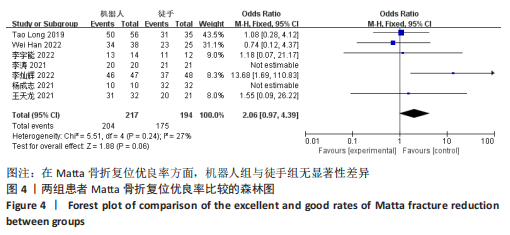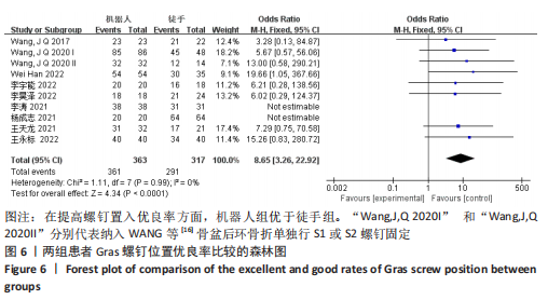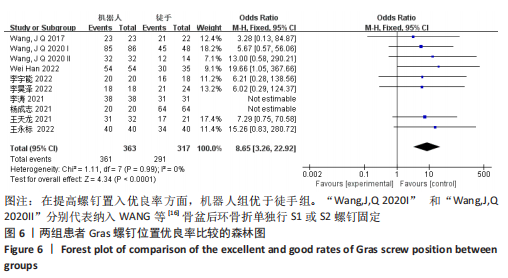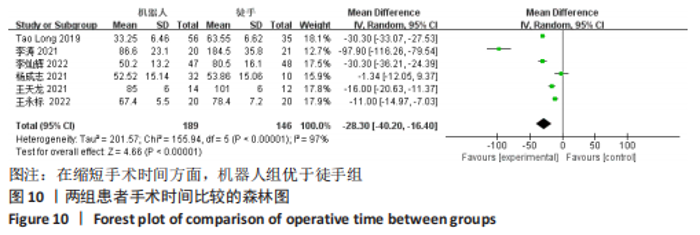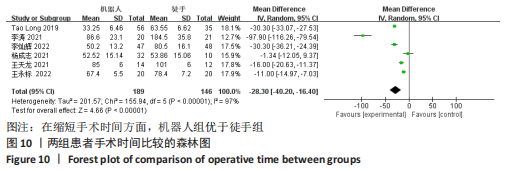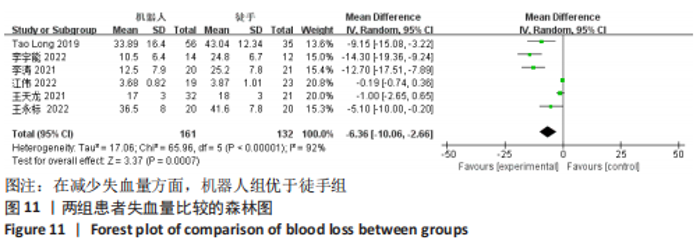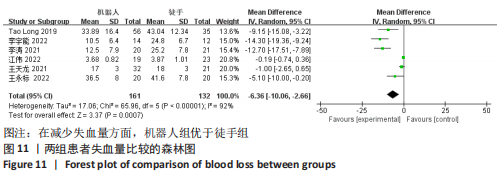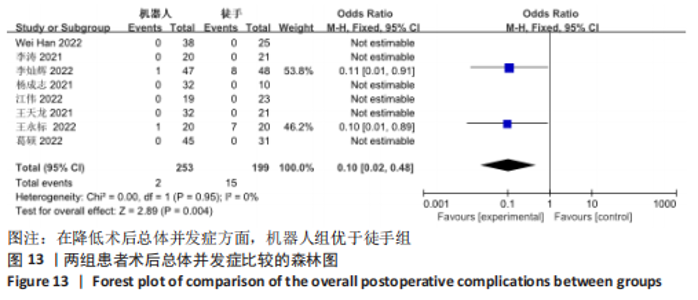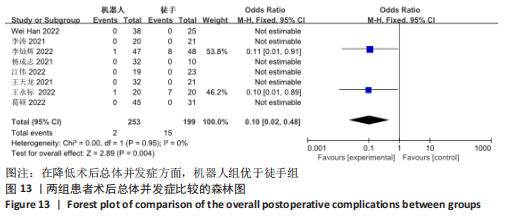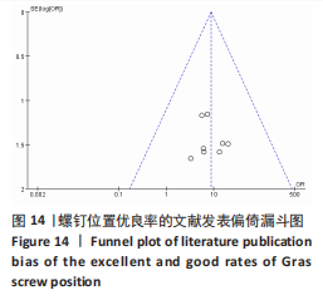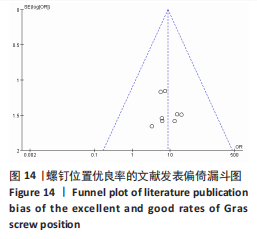Chinese Journal of Tissue Engineering Research ›› 2024, Vol. 28 ›› Issue (18): 2932-2938.doi: 10.12307/2024.033
Previous Articles Next Articles
Meta-analysis of efficacy of orthopedic robot-assisted versus freehand percutaneous sacroiliac screw fixation for posterior pelvic ring fractures
Zhang Guoxu1, Zeng Jianbo2, Li Jing1, Xie Qijun1, Zhou Guanbin1, Guan Jianhao2, Chen Wenchuang1, Chen Haiyun2
- 1Second Clinical College of Guangzhou University of Chinese Medicine, Guangzhou 510120, Guangdong Province, China; 2Second Affiliated Hospital of Guangzhou University of Chinese Medicine/Guangdong Provincial Hospital of Chinese Medicine, Guangzhou 510000, Guangdong Province, China
-
Received:2023-02-16Accepted:2023-04-07Online:2024-06-28Published:2023-08-26 -
Contact:Chen Haiyun, Master, Chief physician, Second Affiliated Hospital of Guangzhou University of Chinese Medicine/Guangdong Provincial Hospital of Chinese Medicine, Guangzhou 510000, Guangdong Province, China -
About author:Zhang Guoxu, Master, Physician, Second Clinical College of Guangzhou University of Chinese Medicine, Guangzhou 510120, Guangdong Province, China -
Supported by:Key Project of Zhuhai Science and Technology Innovation Bureau, No. 2220004000372 (to CHY)
CLC Number:
Cite this article
Zhang Guoxu, Zeng Jianbo, Li Jing, Xie Qijun, Zhou Guanbin, Guan Jianhao, Chen Wenchuang, Chen Haiyun. Meta-analysis of efficacy of orthopedic robot-assisted versus freehand percutaneous sacroiliac screw fixation for posterior pelvic ring fractures[J]. Chinese Journal of Tissue Engineering Research, 2024, 28(18): 2932-2938.
share this article
Add to citation manager EndNote|Reference Manager|ProCite|BibTeX|RefWorks

2.4.4 透视频率 共3个研究报道了透视频率比较结果[19-20,23],共纳入174例患者,其中机器人组95例,徒手组79例。异质性检验结果显示,I2=98%,P < 0.000 01,纳入研究的文献异质性较高。通过逐个剔除文献的方法进行敏感性分析发现,剔除李涛[23]的研究后,异质性明显降低但仍较高(I2=87%,P=0.005),分析原因为该篇文献在进行机器人采集图像时,除采集骨盆出、入口位片外还拍摄骶骨侧位图像,另外主刀医师手术经验的不同也会导致差异性较大。故选取随机效应模型进行分析,结果显示骨科手术机器人辅助置钉的透视频率少于传统方式置钉(MD=-17.39,95%CI:-29.00至-5.78,P=0.003),见图7。 "

| [1] CHU CH, TENNAKOON L, MAGGIO PM, et al. Trends in the management of pelvic fractures, 2008–2010. J Sur Res. 2016; 202(2):335-340. [2] MEJIA DA, PARRA M, ORDOÑEZ CA, et al. Hemodynamically Unstable Pelvic Fracture: A Damage Control Surgical Algorithm that Fits your Reality. Colomb Med (Cali). 2020;51(4):e4214510. [3] GÄNSSLEN A, POHLEMANN T, PAUL C, et al. Epidemiology of pelvic ring injuries. Injury. 1996;27:13-20. [4] PERRY JJ. Pelvic open fractures. Clin Orthop Relat Res. 1980;(151):41-45. [5] DEMETRIADES D, KARAISKAKIS M, TOUTOUZAS K, et al. Pelvic fractures: epidemiology and predictors of associated abdominal injuries and outcomes. J Am Coll Surg. 2002;195(1):1-10. [6] VRAHAS M, HERN TC, DIANGELO D, et al. Ligamentous contributions to pelvic stability. Orthopedics. 1995;18(3):271-274. [7] IORIO JA, JAKOI AM, REHMAN S. Percutaneous Sacroiliac Screw Fixation of the Posterior Pelvic Ring. Orthop Clin North Am. 2015;46(4):511-521. [8] LETOURNEL E. Pelvic fractures. Injury. 1978; 10(2):145-148. [9] CHIP ROUTT ML, MEIER MC, KREGOR PJ, et al. Percutaneous iliosacral screws with the patient supine technique. Operat Tech Orthop. 1993;3(1):35-45. [10] CHIP ROUTT ML, KREGOR PJ, SIMONIAN PT, et al. Early Results of Percutaneous Iliosacral Screws Placed with the Patient in the Supine Position. J Orthopa Trauma. 1995;9(3):207-214. [11] KIM CH, KIM JW. Plate versus sacroiliac screw fixation for treating posterior pelvic ring fracture: a Systematic review and meta-analysis. Injury. 2020;51(10):2259-2266. [12] FERNÁNDEZ-FERNÁNDEZ R, DIAZ-FREIRE P, RUBIO-SUÁREZ JC. Open reduction and navigated Iliosacral screws for vertically unstable pelvic fractures. Injury. 2021;52 Suppl 4:S22-S26. [13] LIU Y. Potential Risk of Intelligent Technologies in Clinical Orthopedics. Adv Exp Med Biol. 2018;1093:281-288. [14] SCHUIJT HJ, HUNDERSMARCK D, SMEEING D, et al. Robot-assisted fracture fixation in orthopaedic trauma surgery: a systematic review. OTA Int. 2021;4(4):e153. [15] AL-NASEEM A, SALLAM A, GONNAH A, et al. Robot-assisted versus conventional percutaneous sacroiliac screw fixation for posterior pelvic ring injuries: a systematic review and meta-analysis. Eur J Orthop Surg Traumatol. 2023;33(1):9-20. [16] WANG J, ZHANG T, HAN W, et al. Robot-assisted S2 screw fixation for posterior pelvic ring injury. Injury. 2020:S0020-1383 (20)30969-4. [17] HAN W, ZHANG T, SU YG, et al. Percutaneous Robot-Assisted versus Freehand S(2) Iliosacral Screw Fixation in Unstable Posterior Pelvic Ring Fracture. Orthop Surg. 2022;14(2):221-228. [18] WANG JQ, WANG Y, FENG Y, et al. Percutaneous Sacroiliac Screw Placement: A Prospective Randomized Comparison of Robot-assisted Navigation Procedures with a Conventional Technique. Chin Med J (Engl). 2017; 130(21):2527-2534. [19] LONG T, LI KN, GAO JH, et al. Comparative Study of Percutaneous Sacroiliac Screw with or without TiRobot Assistance for Treating Pelvic Posterior Ring Fractures. Orthop Surg. 2019;11(3):386-396. [20] 江伟, 杨灵, 汪红, 等. 骨科机器人辅助下骶髂关节螺钉治疗骨盆后环骨折的疗效研究[J]. 华西医学,2022,37(4):550-555. [21] 李灿辉, 吴征杰, 曾焰辉, 等. 骨科手术机器人辅助与传统透视下经皮骶髂螺钉置入的优劣分析[J]. 中国组织工程研究, 2022,26(9):1434-1438. [22] 李昊泽. 经皮骶髂螺钉置入:机器人辅助与传统技术的比较[D]. 太原:山西医科大学,2022. [23] 李涛. TiRobot机器人辅助下经皮螺钉内固定治疗骨盆骨折的临床效果分析[D]. 济南:山东大学,2021. [24] 李宇能, 刘昊楠, 赵春鹏, 等. 急诊骨科手术机器人辅助经皮固定骶髂关节螺钉治疗不稳定型骨盆后环骨折的临床研究[J]. 中华创伤骨科杂志,2022,24(3):194-199. [25] 王天龙, 周子斐, 刘俊峰, 等. TiRobot机器人联合O形臂X线机微创治疗C型骨盆骨折的疗效[J]. 中华创伤杂志,2021, 37(8):701-707. [26] 杨成志, 黄站珠, 唐经励, 等. 骨科手术机器人与“O”型臂X线导航辅助骨盆骨折经皮内固定术的比较[J]. 中华骨科杂志,2021,41(19):1387-1395. [27] 葛硕, 张雷, 周子斐, 等. 天玑骨科机器人联合O臂导航系统辅助经皮微创治疗骨盆后环损伤[J]. 中国修复重建外科杂志,2022,36(8):934-939. [28] 王永标, 冯小仍, 姚艺艺, 等. 天玑骨科手术机器人结合三维成像技术辅助微创治疗骨盆骨折的疗效分析[J]. 中华创伤骨科杂志,2022,24(10):856-861. [29] WU T, REN X, CUI Y, et al. Biomechanical study of three kinds of internal fixation for the treatment of sacroiliac joint disruption using biomechanical test and finite element analysis. J Orthop Surg Res. 2018;13(1):152. [30] HYUN SJ, JUNG JM, KIM KJ, et al. Durability and Failure Types of S2-Alar-Iliac Screws: An Analysis of 312 Consecutive Screws. Oper Neurosurg (Hagerstown). 2020;20(1):91-97. [31] WU T, CHEN W, LI X, et al. Biomechanical comparison of three types of internal fixation in a type C zone II pelvic fracture model. Int J Clin Exp Med. 2015;8(2):1853-1861. [32] AHMAD TA, GILCHRIST I. X-ray canary in the cath lab: Posterior cataracts. Catheter Cardiovasc Interv. 2018;91(4):655-656. [33] HAN MA, KIM JH. Diagnostic X-Ray Exposure and Thyroid Cancer Risk: Systematic Review and Meta-Analysis. Thyroid. 2018; 28(2):220-228. [34] BARTLEY K, METAYER C, SELVIN S, et al. Diagnostic X-rays and risk of childhood leukaemia. Int J Epidemiol. 2010;39(6): 1628-1637. [35] JACOFSKY DJ, ALLEN M. Robotics in Arthroplasty: A Comprehensive Review. J Arthroplasty. 2016;31(10):2353-2363. [36] BARGAR WL, BAUER A, BÖRNER M. Primary and revision total hip replacement using the Robodoc system. Clin Orthop Relat Res. 1998;(354):82-91. [37] LANG JE, MANNAVA S, FLOYD AJ, et al. Robotic systems in orthopaedic surgery. J Bone Joint Surg Br. 2011;93(10):1296-1299. [38] PENG YN, TSAI LC, HSU HC, et al. Accuracy of robot-assisted versus conventional freehand pedicle screw placement in spine surgery: a systematic review and meta-analysis of randomized controlled trials. Ann Transl Med. 2020;8(13):824. [39] LÜTZNER J, KRUMMENAUER F, WOLF C, et al. Computer-assisted and conventional total knee replacement: a comparative, prospective, randomised study with radiological and CT evaluation. J Bone Joint Surg Br. 2008;90(8):1039-1044. [40] RINGEL F, STÜER C, REINKE A, et al. Accuracy of robot-assisted placement of lumbar and sacral pedicle screws: a prospective randomized comparison to conventional freehand screw implantation. Spine (Phila Pa 1976). 2012;37(8):E496-E501. [41] CHENG H, CHEN BP, SOLEAS IM, et al. Prolonged Operative Duration Increases Risk of Surgical Site Infections: A Systematic Review. Surg Infect (Larchmt). 2017;18(6):722-735. [42] MASTRANGELO G, FEDELI U, FADDA E, et al. Increased cancer risk among surgeons in an orthopaedic hospital. Occup Med (Lond). 2005;55(6):498-500. [43] GOOD CR, OROSZ L, SCHROERLUCKE SR, et al. Complications and Revision Rates in Minimally Invasive Robotic-Guided Versus Fluoroscopic-Guided Spinal Fusions: The MIS ReFRESH Prospective Comparative Study. Spine (Phila Pa 1976). 2021;46(23): 1661-1668. [44] ZHANG J, NG N, SCOTT C, et al. Robotic arm-assisted versus manual unicompartmental knee arthroplasty : a systematic review and meta-analysis of the MAKO robotic system. Bone Joint J. 2022;104-B(5):541-548. [45] GE Y, ZHAO C, WANG Y, et al. Robot-Assisted Autonomous Reduction of a Displaced Pelvic Fracture: A Case Report and Brief Literature Review. J Clin Med. 2022;11(6):1598. [46] PASTOR T, TIZIANI S, KASPER CD, et al. Quality of reduction correlates with clinical outcome in pelvic ring fractures. Injury. 2019;50(6):1223-1226. |
| [1] | Zhong Jun, Wang Wen. Network meta-analysis of different anatomical repair strategies to improve chronic lateral ankle instability [J]. Chinese Journal of Tissue Engineering Research, 2024, 28(9): 1470-1476. |
| [2] | Chen Mengmeng, Bao Li, Chen Hao, Jia Pu, Feng Fei, Shi Guan, Tang Hai. Biomechanical characteristics of a novel interspinous distraction fusion device BacFuse for the repair of lumbar degenerative disease [J]. Chinese Journal of Tissue Engineering Research, 2024, 28(9): 1325-1329. |
| [3] | Niu Hegang, Yang Kun, Zhang Jingjing, Yan Yizhu, Zhang Yinshun. Design of a new posterior atlas fracture reduction and internal fixation system [J]. Chinese Journal of Tissue Engineering Research, 2024, 28(9): 1399-1402. |
| [4] | Wang Menghan, Qi Han, Zhang Yuan, Chen Yanzhi. Three kinds of 3D printed models assisted in treatment of Robinson type II B2 clavicle fracture [J]. Chinese Journal of Tissue Engineering Research, 2024, 28(9): 1403-1408. |
| [5] | Yang Cekai, Cai Zhuoyan, Chen Ming, Liu Hao, Weng Rui, Cui Jianchao, Zhang Shuncong, Yao Zhensong. Relationship between degeneration of paraspinal muscle and refractures in postmenopausal women treated by percutaneous vertebroplasty [J]. Chinese Journal of Tissue Engineering Research, 2024, 28(9): 1414-1419. |
| [6] | Dai Yuexing, Zheng Liqin, Wu Minhui, Li Zhihong, Li Shaobin, Zheng Desheng, Lin Ziling. Effect of vessel number on computational fluid dynamics in vascular networks [J]. Chinese Journal of Tissue Engineering Research, 2024, 28(8): 1206-1210. |
| [7] | Tong Yibo, Li Minghui. Influencing factors of adjacent vertebral re-fracture in patients with osteoporotic vertebral fractures after percutaneous vertebroplasty [J]. Chinese Journal of Tissue Engineering Research, 2024, 28(8): 1241-1246. |
| [8] | Zhuang Xinyi, Peng Yuanhao, Yu Ting, Lyu Dongmei, Wen Xiujie, Cheng Qian. Cone-beam CT evaluation of bone mass in the external oblique line of the mandible in adolescents with different cervical vertebral bone ages [J]. Chinese Journal of Tissue Engineering Research, 2024, 28(8): 1253-1258. |
| [9] | Ma Shuwei, He Sheng, Han Bing, Zhang Liaoyun. Exosomes derived from mesenchymal stem cells in treatment of animals with acute liver failure: a meta-analysis [J]. Chinese Journal of Tissue Engineering Research, 2024, 28(7): 1137-1142. |
| [10] | Xue Xiaofeng, Wei Yongkang, Qiao Xiaohong, Du Yuyong, Niu Jianjun, Ren Lixin, Yang Huifeng, Zhang Zhimin, Guo Yuan, Chen Weiyi. Finite element analysis of osteoporosis in proximal femur after cannulated screw fixation for femoral neck fracture [J]. Chinese Journal of Tissue Engineering Research, 2024, 28(6): 862-867. |
| [11] | Huang Peizhen, Dong Hang, Cai Qunbin, Lin Ziling, Huang Feng. Finite element analysis of anterograde and retrograde intramedullary nail for different areas of femoral shaft fractures [J]. Chinese Journal of Tissue Engineering Research, 2024, 28(6): 868-872. |
| [12] | Tan Nengxian, Wu Wenzheng, Zheng Churong, Luo Lieliang, Gu Peng, Ouyang Chongzhi, Zheng Xiaohui. Finite element analysis of different fixation methods of partially threaded cannulated screws for treating vertical femoral neck fractures [J]. Chinese Journal of Tissue Engineering Research, 2024, 28(6): 873-878. |
| [13] | Wang Mingming, Zhang Zhong, Sun Jianhua, Zhao Gang, Song Hua, Yan Huadong, Lyu Bin. Finite element analysis of three different minimally invasive fixation methods for distal tibial fractures with soft tissue injury [J]. Chinese Journal of Tissue Engineering Research, 2024, 28(6): 879-885. |
| [14] | Wu Zhonghan, Wang Jingkun, Li Tao, Xu Xinzhong, Yu Shuisheng, Cheng Li, Tian Dasheng, Tang Jian, Jing Juehua. Proximal femoral nail antirotation for femoral intertrochanteric fractures with lateral wall integrity and lateral wall risk [J]. Chinese Journal of Tissue Engineering Research, 2024, 28(6): 911-916. |
| [15] | Zheng Jiafa, Song Xiufeng, Li Hongzhi, Zhou Jinming, Guan Shengyi, Yu He. Open reduction and internal fixation via the para-Achilles tendon approach for the treatment of posterior malleolus sandwich fractures [J]. Chinese Journal of Tissue Engineering Research, 2024, 28(6): 934-938. |
| Viewed | ||||||
|
Full text |
|
|||||
|
Abstract |
|
|||||
